



Truss Optimisation in Grammatical Evolution Dr. Michael Fenton Michael.Fenton@ucd.ie
Housekeeping: What is a truss?
Why is this important? • Eiffel Tower • 7,300 tons • Wrought Iron • 10% weight saving = 730 tons • Savings “snowball” and scale down through entire structure • Lighter structure needs less support, etc.
Why Human-Competitive?
Theoretical Limitations • Michell, A.G.M., 1904. LVIII. The limits of economy of material in frame-structures. The London, Edinburgh, and Dublin Philosophical Magazine and Journal of Science , 8(47), pp.589-597.
Traditional Ground Structure Image credit: [4]
Traditional Ground Structure Nodes = n Connections c = ((n-1)n)/2 Permutations = tetrahedral number + number of connections = ((c-1)*c*(c+1))/6 + c ~ O(n 6 )
SEOIGE [2] Blue = Compression Red = Tension
SEOIGE [2] Recursive node-based grammar: a ::= [<nodes>] <nodes> ::= <node> | <node>,<nodes> <node> ::= [<%>, <%>] <%> ::= <n><n>.<n><n> <n> ::= 0|1|2|3|4|5|6|7|8|9 • 10 8*(d-2) unique solutions at depth d
Why Best HUMIES Entrant?
Why Best HUMIES Entrant? • The methods described in paper [2] represent an entirely new way to generate truss structures, previously unseen in the literature. • Intelligent, lightweight representation. • Use of triangulation: all generated solutions are kinematically stable, and as such are structurally viable (constraints notwithstanding). • Pinnacle of engineering optimisation after over 100 years of research in the field. • Real-world application with commercial appeal. • Designed with this in mind. • Real-world materials and constraints.
Sustainable Development • Minimizing material usage has a number of benefits: • Immediate cost benefit. • “Snowball” effect of weight reduction over entire structure. • Material minimisation: effect on supply and demand. • With an average estimate of 2 tons of CO2 being emitted for every 1 ton of steel produced [5], any reduction in production has significant environmental implications.
Acknowledgements This research is based upon works supported by Science Foundation Ireland under grant 13/IA/1850.
References 1. Fenton, M., McNally, C., Byrne, J., Hemberg, E., McDermott, J. and O'Neill, M., 2014. Automatic innovative truss design using grammatical evolution. Automation in Construction , 39, pp.59-69. 2. Fenton, M., McNally, C., Byrne, J., Hemberg , E., McDermott, J. and O’Neill, M., 2016. Discrete planar truss optimization by node position variation using grammatical evolution. IEEE Transactions on Evolutionary Computation , 20(4), pp.577-589. 3. Michell, A.G.M., 1904. LVIII. The limits of economy of material in frame-structures. The London, Edinburgh, and Dublin Philosophical Magazine and Journal of Science , 8(47), pp.589-597. 4. Torii, A.J., Lopez, R.H. and Miguel, L.F., 2016. Design complexity control in truss optimization. Structural and Multidisciplinary Optimization , 2(54), pp.289-299. 5. Global CCS Institute, 2013. CCS for iron and steel production. Available online at: https://www.globalccsinstitute.com/insights/authors/dennisvanpuyvelde/2013/08/23/ ccs-iron-and-steel-production
Recommend
More recommend